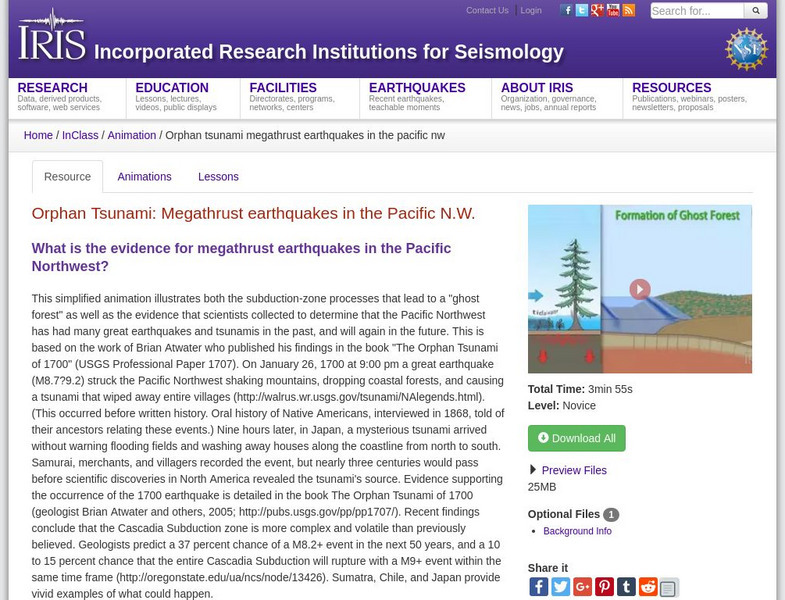Hi, what do you want to do?
Incorporated Research Institutions for Seismology
Iris: Subduction Zone: Simplified Model of Elastic Rebound
Understand how energy disperses during an earthquake. This brief video will illustrate the theory of elastic rebound. [:25]
Incorporated Research Institutions for Seismology
Iris: 3 Component Seismogram Records Seismic Wave Motion
This animation shows both the movement of the three basic waves (P, S, and surface) and the effect of the waves on a building. It emphasizes that seismic waves traveling away from an earthquake occur everywhere, not just at seismic...
Incorporated Research Institutions for Seismology
Iris: Basin & Range: Structural Evolution
Animation illustrates extension and deformation in a basin-&-range province. [1:05]
Incorporated Research Institutions for Seismology
Iris: Basin & Range: Volcanoes
Animation explores how basin and range processes can lead to four types of volcanic eruptions. [1:10]
Incorporated Research Institutions for Seismology
Iris: Earthquakes Scattered Across the Globe Recorded by One Station
Animation features a gridded sphere that shows a seismic station recording 10 different earthquakes that are widely scattered. [1:22]
Incorporated Research Institutions for Seismology
Iris: Seismic Tomography (Ct Scan as Analogy)
How do scientists look at the layers of the Earth? They have the seismic version of a CT scan, of course. Understand this process with the help of the video. [2:52]
Incorporated Research Institutions for Seismology
Iris: Build a Better Wall 1: Parts & Construction
A video lecture that introduces a technique that can be used to make buildings earthquake-resistant. The instructor demonstrates and explains how to use simple materials to build a shear wall for a building. [9:15]
Incorporated Research Institutions for Seismology
Iris: Build a Better Wall Demo: Why Buildings Fail
A video lecture that looks at what factors impact on the amount of damage that is caused by an earthquake. These depend on the intensity of the vibrations and the methods of construction used in the buildings. [6:05]
Incorporated Research Institutions for Seismology
Iris: Earthquake Early Warning: Pacific Northwest Subduction Zone
Animation explores how an earthquake early warning system works and shows how ground motion, measured by GPS, can enhance earthquake early warning. [6:57]
Incorporated Research Institutions for Seismology
Iris: Focal Mechanisms Explained
Focal mechanisms are based on the direction of the first arriving P wave. This animation walks the viewer through steps to understand how scientists know what kind of fault motion occurred deep underground. [6:35]
Incorporated Research Institutions for Seismology
Iris: New Madrid Region: Geologic History in Cross Section
Studies of the rocks in New Madrid tell quite a story. This is an animation illustrating how the scenery changed over 500 million years. [0:54]
Incorporated Research Institutions for Seismology
Iris: Orphan Tsunami: Megathrust Earthquakes in the Pacific n.w.
Review a video that introduces geologic evidence of unique megathrust earthquakes in the Pacific Northwest based on oral history, radiocarbon dating Tree-ring analysis as well as Samurai records dating back to the beginning of the...
Incorporated Research Institutions for Seismology
Iris: Pacific Northwest vs Japan: Similar Tectonic Settings
Investigate what GPS can do to help study and predict future earthquakes. [4:12]
Incorporated Research Institutions for Seismology
Iris: Pacific Northwest: Three Types of Tectonic Earthquakes
A video illustrates the concern scientists have over an inevitable megathrust earthquake due to the stress building between the Juan de Fuca and North American plates. Be sure to look at the additional resources found under the video...
Incorporated Research Institutions for Seismology
Iris: Pakistan: Earthquakes and Tectonics
Plate tectonics shift all over Earth. This video illustrates what happened in Pakistan in 2013. [1:59]
Incorporated Research Institutions for Seismology
Iris: Peru Chile Subduction Zone: Earthquakes & Tectonics
A detailed video featuring the challenges of western South America and why it is such a hot spot for earthquakes. [10:16]
Incorporated Research Institutions for Seismology
Iris: Seismic Shadow Zones vs Light Shadows
Is it possible to compare Earth's seismic shadow zones to light shadows? Let's find out with this video! [3:16]
Incorporated Research Institutions for Seismology
Iris: Seismic Shadow Zones: P Wave
What can the P wave tell about the core of the Earth? Find out in a video. [3:26]
Incorporated Research Institutions for Seismology
Iris: Seismic Shadow Zones: S Wave Shadow Zone
What do S waves reveal about the Earth's surface? This video will illustrate the research. [2:11]
Incorporated Research Institutions for Seismology
Iris: Seismic Wave Behavior: Curving Paths Through the Earth
Studying the travel paths of seismic waves in the interior of the Earth. Find out what the paths look like and why. [1:31]
Incorporated Research Institutions for Seismology
Iris: Seismograms of Common Events: Compiled
A collection of seismic events recorded near Mount Saint Helens. The seismographs located at stations record seismograms like what are shown here. [2:10]
Incorporated Research Institutions for Seismology
Iris: Shake Alert: Earthquake Early Warning System
The ShakeAlert technology is presented because it is a system to measure when the impact of an earthquake will hit an area. It sends out a notice to the area so the residents can find protection. Find detailed facts provided by the USGS....
Incorporated Research Institutions for Seismology
Iris: Shake Alert: Terremoto De Alerta Temprana
A resource to understand how ShakeAlert helps people know when an earthquake will begin shaking their area. The alert provides people the opportunity to find a safe place. [5:12]
Incorporated Research Institutions for Seismology
Iris: Socorro Magma Body: What It Is and the Monitoring Strategy
How do seismologists monitor a situation in New Mexico? Check out this clip illustrating the Socorro Magma Body study. [4:19]




























